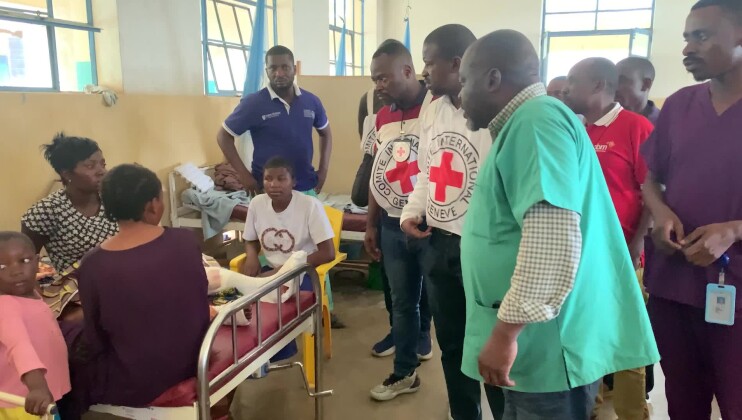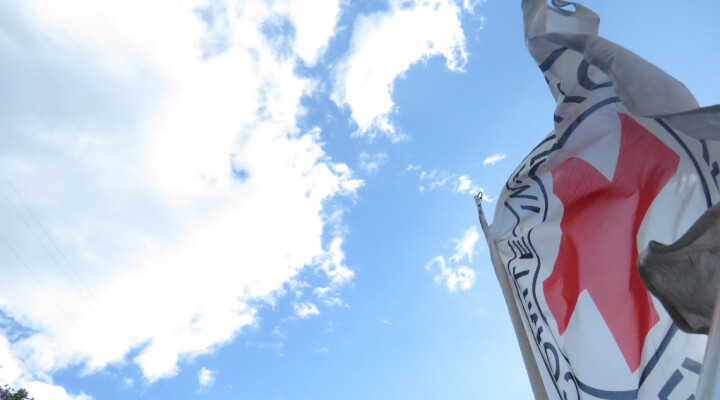Gaza: Ten Years On
In recent months, Gaza has witnessed an accelerated and worrying degradation of the humanitarian situation. Restrictions imposed on the movement of people and goods, aggravated by internal Palestinian differences, has fenced off Gaza from the rest of the world hand is suffocating its economy. Poverty levels have reached their worst according to official statistics. Despite the availability of fruits and vegetables in the market, the purchasing power is low.
For over a decade, the two million people in Gaza have experienced a gradual degradation of all aspects of people’s lives and compromise their access to health care, water and power. The control of Gaza’s three main entry and exit points is at the core of the problem. It exacerbates Gaza’s slow but perpetual economic decline and its dependency on humanitarian aid. Seven out of ten Gazans live off humanitarian aid. While Gaza is among the places with the highest education rates in the world, it also has one of the highest unemployment rates worldwide notably among young graduates standing at over 60% (according to UN statistics, August 2017).
And although the situation in Gaza looks normal on the surface as if life is going on, the chronic electricity problems casts its shadow on the daily life of the people in Gaza.
Chronic power shortages have plagued the Gaza Strip for years and fostered a dependency on power provisions from Egypt and Israel, both of which are insufficient and intermittent.
Gaza’s very own power plant (GPP) which was hit during the 2014 conflict and later repaired, remains unable to meet the needs of the two million people living in the Gaza Strip. To produce power, the plant is heavily reliant on fuel, which must be imported into Gaza. Insufficient fuel imports and scarcity of funds have forced Gaza’s Electricity Distribution Company (GEDCO) to ration its power provision. For the past ten years, power provision schemes have been in place across the Gaza Strip with electricity being available for eight hours a day at best. Fuel, which is used to run generators, outside of the hours power is provided within, can be used by those who can afford it- a minority of Gaza’s population and service providers.
The energy crisis is impacting essential services including the provision of health care services. It is interrupting surgical operations and reducing the operating hours of water and waste water treatment plants or stopping them all together. As a result, 100,000 cubic metres of untreated sewage is pumped into the sea on a daily basis, traveling far beyond Gaza’s borders.
The energy crisis has dealt another blow to the quality of life of people in Gaza. Their daily lives are heavily impacted by the electricity shortages in most neighborhoods in Gaza and people have taken to the planning of their daily chores around the energy crisis.
Despite all the challenges, Palestinian families in Gaza tried to cope with the situation, namely shortage in electricity, to be able to cover their needs. Some families bought UPS chargers, but they only produce enough to operate for lights, TV, and internet router, any heavier equipment, such as refrigerators and laundry machines, cannot be run on UPSs. In some neighborhoods, big electricity generators were installed by individuals for household use. To receive electricity line from the generator, a family has to buy 1KWATT for 3.5 shekels (1 USD) while they used to buy the 1KWATT from the electricity company for 0.5 shekels only (0.14 USD). It means another financial burden for an already stretched families with an average income of 1’500 shekels (420 USD) a month.
Living with chronic power shortages has become the new normal for people in Gaza. The battered infrastructure and the poor economy is already exerting a heavy toll on people here as is. The energy crisis is yet another blow.
Even if people in Gaza manage to find temporary solutions, a durable solution must be found which can only come from the key political actors.
Download this footage from ICRC Video Newsroom
For further information, please contact:
Suhair Zakkout (Arabic and English), ICRC Gaza, tel: +972 59 92 55 381
Iolanda Jaquemet, ICRC Geneva, +41 79 447 37 26
Follow the ICRC on facebook.com/icrc and twitter.com/icrc
SHOTLIST
This AV news footage highlights the impact of the restrictions imposed on Gaza, and of the current energy and economic crisis is having on people’s daily lives.
Length: 10:18
Format: HD H264 mov
ICRC ref: AV673N1
Date: 22 August 2017
Copyright: ICRC access all
0:00 – 0:05
Wide shot showing the cement wall at Erez/Beit Hanoun Crossing, north of Gaza Strip
0:06 – 0:12
Medium shot for the cement wall at Erez/BeitHanoun Crossing, north of Gaza Strip
0:13 – 0:29
A walk in the narrow streets in Shati’ Camp, west of Gaza City
0:30 – 1:38
General shots from the streets of Shati’ Camp showing children and elderly people
1:39 – 1:47
A man walking in one of the streets at Shati’ Camp, west of Gaza City
1:48 – 2:
Palestinian people sitting in the street in front of their houses, escaping the hot weather inside houses
2:00 – 2:18
Close shots of father and sleeping daughter, escaping the hot weather inside houses
2:19 – 2:35
Saleh Alkhaldi, young graduate from Gaza, walking in the narrow streets of his neighbourhood, Shati’ Camp
2:36 – 2:45
Saleh Alkhaldi, young graduate from Gaza, sitting in front of his house greeting neighbours and playing on his mobile phone
2:46 – 3:29
SOUNDBITE Saleh Alkhaldi, 25 years old young graduate from Shati’ Camp in Gaza City, “In 2013, I finished a law secretary diploma degree and in 2015 I completed a bachelor degree in law. Between 2015 and 2017, I looked for a job in my profession, but I couldn’t find any. I had to work in delivery, but it caused some health problems to me three months later so I quit. Since that moment, I looked for another job to fulfil my commitments, but I couldn’t find a proper job neither in my profession nor any other profession.”
3:30 – 3:39
General shots of the tailor shop, Mohammed Albakri from Shati’ Camp in Gaza City
3:40 – 4:02
Mohammed Albakri, tailor from Gaza, fixing clothes and school bags to suit people’s sizes
4:03 – 4:11
Mohammed Albakri, tailor from Gaza, receiving client to fix his pants
4:12 – 5:00
SOUNDBITE Mohammed Albakri, 40 years old tailor from Shati’ Camp in Gaza City, “I have been a tailor for 27 years. When crossings were open, the situation was much better. Now, I don’t tailor at all. A person like me earns only 10 – 20 shekels a day. I depend on fixing clothes during school and feast seasons. People don’t have enough money to buy or custom new clothes. If people came to tailor, I work and if I work, I buy food for my family. This moment, I’m not able to cover the rental expenses of my shop. ”
5:01 – 5:18
Top views of the market in Shati’ Camp, west of Gaza City
5:19 – 5:36
General shots of the market in Shati’ Camp, west of Gaza City
5:37 – 5:55
Faten Alghalayini, housewife from Shati’ Camp, filling in glass of water and putting her insulin bottle to keep it from getting spoiled
5:56 – 6:07
SOUNDBITE Faten Alghalayini, 46 years old housewife from Al Shati’ Camp in Gaza City, “The continuous power cuts caused my insulin to get spoiled. If the bottle is open, it has to be kept in the refrigerator. With electricity cuts, the refrigerator became more like a cupboard.”
6:08 – 6:14
Palestinian boy from Gaza sitting in front of a shop using a generator
6:15 – 6:22
Close shot of the electricity generator
6:23 – 6:51
Shots of Faten’s husband changing the electricity line from UPS to generator’s electricity line
6:52 – 7:21
SOUNDBITE Faten Alghalayini, 46 years old housewife from Al Shati’ Camp in Gaza City, “My husband bought UPS as an alternative for the regular electricity line, but its batteries do not last long. If the kids turned the TV on for 15 minutes, the UPS start to buzz. Another alternative we found was to get an electricity line from our neighbour’s generator, but this option is very expensive. We pay for the generators’ line seven times more than the regular electricity line; the 1KWATT of regular electricity costs 0.5 shekels (0.14 USD) while the 1KWATT from the generator costs 3.5 shekels (1 USD). This impacts our expenses budget too ”
7:22 – 7:59
General shots of water truck driver filling in water tanks for Palestinian family in Gaza
8:00 – 8:13
SOUNDBITE Mohammed Alseikh Deeb, 25 years old water truck driver from Gaza, “We used to have electricity for eight hours a day. Then it decreases to four then two hours. This created more pressure on us as we receive lots of phone calls because people are not only using the water for drinking, but also to cook and wash clothes.”
8:14 – 8:30
General shots of Gaza City beach
8:31 – 9:00
General medium and close shots of youth and children swimming in the sea of Gaza City
9:01 – 10:02
General medium and close shots of wastewater disposal into the sea in the Wadi Gaza area, middle of Gaza Strip
10:03 – 10:18
General medium and close shots of signs put by the municipalities discouraging people to swim or fish in the sea because water is polluted.



